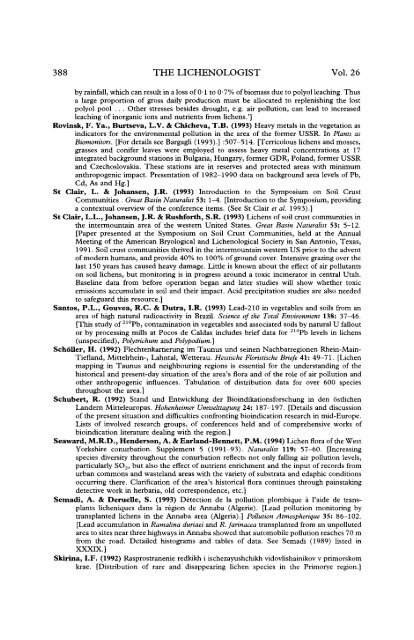Literature on Air Pollution and Lichens XL
Literature on Air Pollution and Lichens XL
Literature on Air Pollution and Lichens XL
Create successful ePaper yourself
Turn your PDF publications into a flip-book with our unique Google optimized e-Paper software.
388 THE LICHENOLOGIST Vol. 26<br />
by rainfall, which can result in a loss of 01 to 0-7% of biomass due to polyol leaching. Thus<br />
a large proporti<strong>on</strong> of gross daily producti<strong>on</strong> must be allocated to replenishing the lost<br />
polyol pool . . . Other stresses besides drought, e.g. air polluti<strong>on</strong>, can lead to increased<br />
leaching of inorganic i<strong>on</strong>s <strong>and</strong> nutrients from lichens.']<br />
Rovinsk, F. Ya., Burtseva, L.V. & Chicheva, T.B. (1993) Heavy metals in the vegetati<strong>on</strong> as<br />
indicators for the envir<strong>on</strong>mental polluti<strong>on</strong> in the area of the former USSR. In Plants as<br />
Biom<strong>on</strong>itors. [For details see Bargagli (1993).] :507-514. [Terricolous lichens <strong>and</strong> mosses,<br />
grasses <strong>and</strong> c<strong>on</strong>ifer leaves were employed to assess heavy metal c<strong>on</strong>centrati<strong>on</strong>s at 17<br />
integrated background stati<strong>on</strong>s in Bulgaria, Hungary, former GDR, Pol<strong>and</strong>, former USSR<br />
<strong>and</strong> Czechoslovakia. These stati<strong>on</strong>s are in reserves <strong>and</strong> protected areas with minimum<br />
anthropogenic impact. Presentati<strong>on</strong> of 1982-1990 data <strong>on</strong> background area levels of Pb,<br />
Cd, As <strong>and</strong> Hg.]<br />
St Clair, L. & Johansen, J.R. (1993) Introducti<strong>on</strong> to the Symposium <strong>on</strong> Soil Crust<br />
Communities . Great Basin Naturalist 53: 1-4. [Introducti<strong>on</strong> to the Symposium, providing<br />
a c<strong>on</strong>textual overview of the c<strong>on</strong>ference items. (See St Clair et al. 1993).]<br />
St Clair, L.L., Johansen, J.R. & Rushforth, S.R. (1993) <strong>Lichens</strong> of soil crust communities in<br />
the intermountain area of the western United States. Great Basin Naturalist S3: 5-12.<br />
[Paper presented at the Symposium <strong>on</strong> Soil Crust Communities, held at the Annual<br />
Meeting of the American Bryological <strong>and</strong> Lichenological Society in San Ant<strong>on</strong>io, Texas,<br />
1991. Soil crust communities thrived in the intermountain western US prior to the advent<br />
of modern humans, <strong>and</strong> provide 40% to 100% of ground cover. Intensive grazing over the<br />
last 150 years has caused heavy damage. Little is known about the effect of air pollutants<br />
<strong>on</strong> soil lichens, but m<strong>on</strong>itoring is in progress around a toxic incinerator in central Utah.<br />
Baseline data from before operati<strong>on</strong> began <strong>and</strong> later studies will show whether toxic<br />
emissi<strong>on</strong>s accumulate in soil <strong>and</strong> their impact. Acid precipitati<strong>on</strong> studies are also needed<br />
to safeguard this resource.]<br />
Santos, P.L., Gouvea, R.C. & Dutra, I.R. (1993) Lead-210 in vegetables <strong>and</strong> soils from an<br />
area of high natural radioactivity in Brazil. Science of the Total Envir<strong>on</strong>ment 138: 37-46.<br />
[This study of 2I0 Pb, c<strong>on</strong>taminati<strong>on</strong> in vegetables <strong>and</strong> associated soils by natural U fallout<br />
or by processing mills at Pocos de Caldas includes brief data for 210 Pb levels in lichens<br />
(unspecified), Polytrichum <strong>and</strong> Polypodium.]<br />
Scholler, H. (1992) Flechtenkartierung im Taunus und seinen Nachbarregi<strong>on</strong>en Rhein-Main-<br />
Tiefl<strong>and</strong>, Mittelrhein-, Lahntal, Wetterau. Hessische Floristische Briefe 41: 49-71. [Lichen<br />
mapping in Taunus <strong>and</strong> neighbouring regi<strong>on</strong>s is essential for the underst<strong>and</strong>ing of the<br />
historical <strong>and</strong> present-day situati<strong>on</strong> of the area's flora <strong>and</strong> of the role of air polluti<strong>on</strong> <strong>and</strong><br />
other anthropogenic influences. Tabulati<strong>on</strong> of distributi<strong>on</strong> data for over 600 species<br />
throughout the area.]<br />
Schubert, R. (1992) St<strong>and</strong> und Entwicklung der Bioindikati<strong>on</strong>sforschung in den ostlichen<br />
L<strong>and</strong>ern Mitteleuropas. Hohenheimer Umwelttagung 24: 187-197. [Details <strong>and</strong> discussi<strong>on</strong><br />
of the present situati<strong>on</strong> <strong>and</strong> difficulties c<strong>on</strong>fr<strong>on</strong>ting bioindicati<strong>on</strong> research in mid-Europe.<br />
Lists of involved research groups, of c<strong>on</strong>ferences held <strong>and</strong> of comprehensive works of<br />
bioindicati<strong>on</strong> literature dealing with the regi<strong>on</strong>.]<br />
Seaward, M.R.D., Henders<strong>on</strong>, A. & Earl<strong>and</strong>-Bennett, P.M. (1994) Lichen floraof the West<br />
Yorkshire c<strong>on</strong>urbati<strong>on</strong>. Supplement 5 (1991-93). Naturalist 119: 57-60. [Increasing<br />
species diversity throughout the c<strong>on</strong>urbati<strong>on</strong> reflects not <strong>on</strong>ly falling air polluti<strong>on</strong> levels,<br />
particularly SO 2 , but also the effect of nutrient enrichment <strong>and</strong> the input of records from<br />
urban comm<strong>on</strong>s <strong>and</strong> wastel<strong>and</strong> areas with the variety of substrata <strong>and</strong> edaphic c<strong>on</strong>diti<strong>on</strong>s<br />
occurring there. Clarificati<strong>on</strong> of the area's historical flora c<strong>on</strong>tinues through painstaking<br />
detective work in herbaria, old corresp<strong>on</strong>dence, etc.]<br />
Setnadi, A. & Deruelle, S. (1993) Detecti<strong>on</strong> de la polluti<strong>on</strong> plombique a l'aide de transplants<br />
licheniques dans la regi<strong>on</strong> de Annaba (Algerie). [Lead polluti<strong>on</strong> m<strong>on</strong>itoring by<br />
transplanted lichens in the Annaba area (Algeria).] Polluti<strong>on</strong> Atmospherique 35: 86-102.<br />
[Lead accumulati<strong>on</strong> in Ramalina duriaei <strong>and</strong> R. farinacea transplanted from an unpolluted<br />
area to sites near three highways in Annaba showed that automobile polluti<strong>on</strong> reaches 70 m<br />
from the road. Detailed histograms <strong>and</strong> tables of data. See Semadi (1989) listed in<br />
XXXIX.]<br />
Skirina, I.F. (1992) Rasprostranenie redkikh i ischezayushchikh vidovlishainikov v primorskom<br />
krae. [Distributi<strong>on</strong> of rare <strong>and</strong> disappearing lichen species in the Primorye regi<strong>on</strong>.]
















